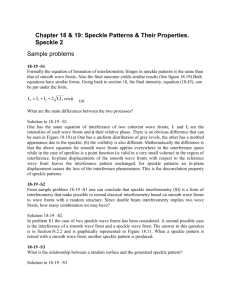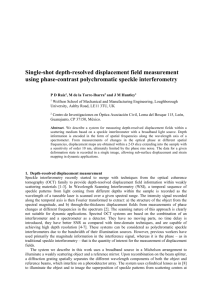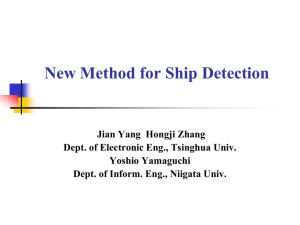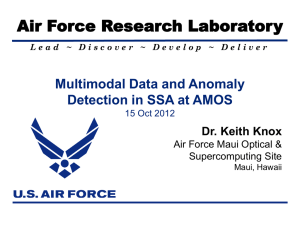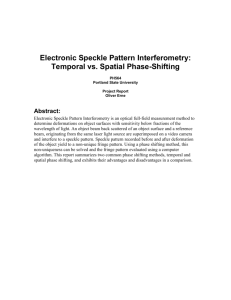astronomical speckle interferometry
advertisement
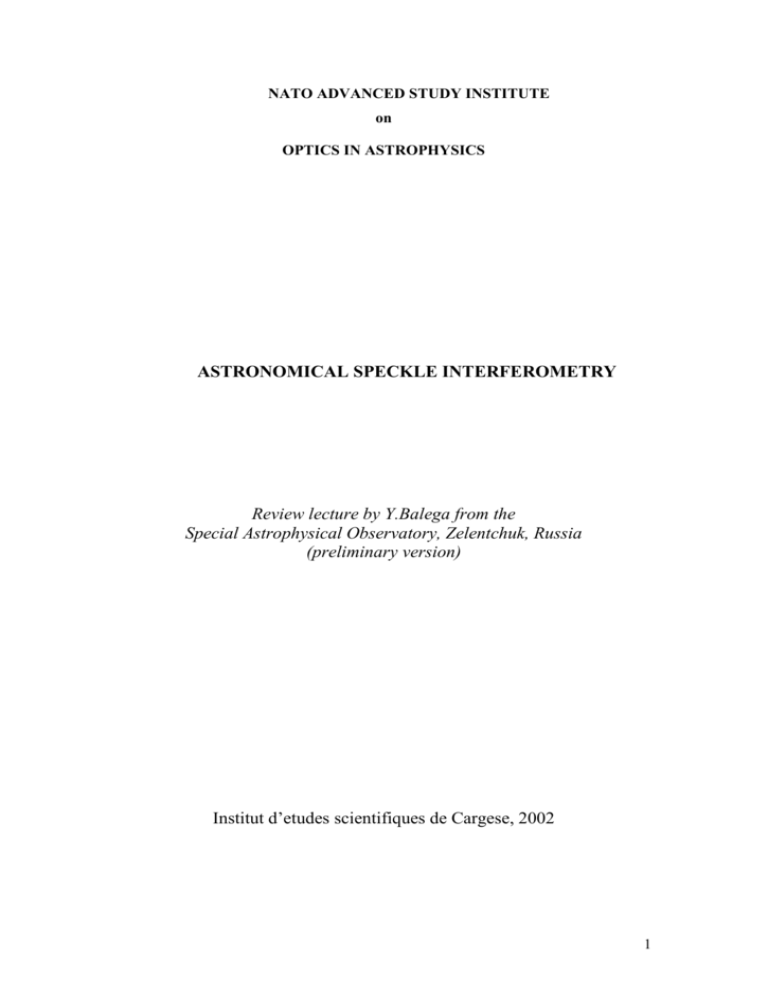
NATO ADVANCED STUDY INSTITUTE
on
OPTICS IN ASTROPHYSICS
ASTRONOMICAL SPECKLE INTERFEROMETRY
Review lecture by Y.Balega from the
Special Astrophysical Observatory, Zelentchuk, Russia
(preliminary version)
Institut d’etudes scientifiques de Cargese, 2002
1
CONTENTS:
1. Introduction
2. Speckle phenomena
3. Object-image relation and the Fried parameter
4. Labeyrie’s proposal
5. Speckle interferometry technology: cameras, detectors, photon noise, photoncounting hole.
6. Speckle holography
7. Shift-and-add algorithm
8. Knox-Thomson method
9. Speckle masking
10. Differential speckle interferometry
11. Astronomical applications of speckle interferometry
1. Introduction
Everybody knows that telescopes make things bigger: the bigger the telescope the
more there is to see. However, atmospheric turbulence limits angular resolution to
about 1 arcsec; consequently, a 10-m telescope has approximately the same resolving
capabilities as a small 10-cm diameter tube. Resolution limitations caused by the
atmospheric smearing, were first overcame by Michelson and his collaborators in
1920s by making use of interferometric properties of light. As you all know, they
succeeded to measure the angular diameter of the red supergiant star Betelgeuse using
the 5 m baseline installed at the 100-inch telescope. Similar methods have been later
used extensively in radio astronomy and in the optical intensity interferometry to
reach an angular resolution of 0.001 arcsec and better.
Labeyrie (1970) first pointed out that very short exposure photographs contain
information on scales at the telescope diffraction limit. In the 70s the technique called
speckle interferometry became one of the most promising developments in the optical
observational astronomy. It became an extremely active field scientifically with
important contributions made to a wide range of topics in stellar astrophysics. Here
2
we will make a short review of the speckle interferometry and present the most
important results obtained by astronomers using this method at large telescopes.
2. Speckle phenomena
The short-exposure image of a point source formed by a corrugated wave front is
composed of numerous short-lived speckles. Speckles result from the interference of
light from many coherent patches, of typical diameter r0, distributed over the full
aperture of the telescope. J.Texereau (1963) was one of the first who described
correctly the speckle phenomena in his study of limitations of the image quality in
large telescopes. He observed boiling light granules visually using a strong eye-piece
and by means of sensitive photographic films in the focus of the 1.93m telescope at
Haute-Provence. Earlier, visual observers of binary stars, such as W.Finsen, could use
the speckle structure of a binary star image to yield useful information about the
separations and position angles between the components. In this manner they have
been used the speckle interferometry method without knowing about it.
A single r0-size subpupil would form a PSF of width / r0 imposed by diffraction.
Diffraction pattern produced by a circular aperture is called the Airy spot. It is made
of a very bright central spot surrounded by rings, which are alternately dark and
bright. The radius of the first dark ring of the diffraction spot is equal to:
= 1.22 / D
We now consider two small-size subpupils, separated by a distance d, pierced into
an opaque screen in front of the telescope aperture. Each small opening diffracts the
incoming light, which is spread over the focal plane. The observed phenomena of a
modulation pattern of linear interference fringes, is known as Young ‘s fringes. These
are normal to the line joining the two subpupils, and the distance that separates a dark
from a bright fringe (fringe width) is / d.
Atmospheric turbulence causes random phase fluctuations of the incoming optical
wave front. As a result of the randomly varying phase difference between the two
subpupils, the fringe pattern moves by a random amount. Phase fluctuations are
3
equivalent to wave front tilts if the assumed subpupils are smaller than r0. In typical
atmospheric conditions, these fluctuations become uncorrelated when the baseline d
exceeds about 10 cm. When the phase shift between the subpupils is equal or greater
than the fringe spacing / d, fringes will disappear in a long exposure. Instead of
making a long exposure, one can follow their motion by recording a sequence of short
exposures, short enough to “freeze” the instantaneous fringe pattern.
Now let us introduce a third small subpupil in front of the telescope, which is not
collinear with the former two (fig.1). The result will be the pattern of three
intersecting moving fringe systems produced by three nonredundant pairs of
subpupils. When these fringes interfere, an enhanced bright speckles of width / d
appear.
Fig.1. Speckle pattern formation.
The number of speckles Ns per image is defined by the ratio of the area occupied by
the seeing disk / r0 to the area of a single speckle
4
Ns = ( / r0 )2 : ( / D )2 =( D / r0 )2 .
If the atmospheric seeing is good, this corresponds to about 1500 speckles in a single
short exposure image taken with an 8-m telescope. More accurate estimates give three
times less amount of speckles because of the filling factor k = 0.342.
(Insert Fig.2 “Speckle image from the 6-m telescope”)
The speckle lifetime is defined by the velocity dispersion in the turbulent
atmosphere:
r0 / .
Under typical atmospheric conditions, speckle boiling can be frozen with exposures in
the range 0.01 – 0.05 sec.
3. Object-image relation and the Fried parameter
If the atmospheric degradations are isoplanatic all over the telescope field of view, the
irradiance distribution from the object o(x) is related to the long-exposure (ensemble
averaged) observed irradiance distribution < i(x) > by a convolution relation
< i(x) > = o(x) < s(x) >
where the point spread function < s(x) > is simply the long-exposure image of a point
source.
In Fourier space it becomes
< I(u) > = O(u) < S(u) >
where < S(u) > is the optical transfer function of the system “telescope plus
atmosphere”, and u is the spatial frequency vector expressed in radian
–1
. For long
5
exposures, < S(u) > is the product of the transfer function of the telescope T(u) with
the atmospheric transfer function equal to the coherence function B(u) (Roddier
1981):
< S(u) > = T(u) B(u) .
Similar to the bandwidth in radio electronics, Fried (1966) proposed to define the
resolving power of the telescope as the integral of the optical transfer function:
R = < S(u) > du = T(u) B(u) du .
For a large diameter telescope the resolving power depends only upon turbulence and
R = B(u) du.
The Fried parameter r0 has a meaning of the critical telescope diameter for which
B(u) du = T(u) du,
Resolving power of the telescope is limited by the telescope only if D r0 , in other
cases it is limited by the atmosphere.
The relation between atmospheric coherence function and r0 is expressed by:
B(u) = exp –3.44 (u / r0 ) -5/3
(Fried 1966).
Finally, the following two relations show the dependence of r0 upon the refraction
index structure constant Cn (from the Obukhov’s law: the structure function Dn() =
Cn2 2/3 (Tatarski 1961)) and the wavelength :
r0 = [0.423 k2 (cos z)-1 Cn2 (h) dh,
r0 6/5 ,
6
here k = 2 / , and z is the zenith distance.
4. Labeyrie’s method
In the case of short exposures, the image intensity distribution i(x) is again related to
the object distribution o(x) by a convolution relation
i(x) = o(x) s(x) .
The Fourier transform of this intensity recording is
I(u) = O(u) S(u),
and
I(u) 2 = O(u) 2 S(u) 2 ,
here O(u) 2 is the object power spectrum and S(u) 2 is the energy spectrum of a
point source image. S(u) 2 describes how the spectral components of the image
were transmitted by the atmosphere and the telescope. At every moment this function
is not known but its time-averaged value can be determined if the seeing conditions
do not change. Time averaging means that
< I(u) 2> = O(u) 2 <S(u) 2>
which leads to
O(u) 2 = < I(u) 2> / <S(u) 2>.
Eq. … gives the essence of the Labeyrie’s (1970) proposal, namely: if the timeaveraged speckle transfer function is determined from the ensemble of its instant
recordings, the intensity of the object’s Fourier transform can be reconstructed (see
Fig.3). Note that the short-exposure <S(u) 2> is not the same as < S(u) > in eq.(…).
It includes the high spatial frequency component, which extends, as it was shown both
theoretically and from observations, up to the diffraction cut-off limit of the telescope.
7
Fig.3. Labeyrie’s speckle interferometry.
Analytical expression for the power spectrum of short-exposure images was first
proposed by Korff (1973). Its asymptotic behavior is presented in Fig.2, showing that
<S(u) 2> extends up to the ideal telescope diffraction cut-off frequency. That
means that the typical speckle size is of the order of the Airy pattern of the given
aperture. The low-frequency part of <S(u)2> corresponds to a long exposure image
with the wave front tilts compensated.
Fig.3 explains the difference between the long-exposure image acquisition and the
Labeyrie’s reconstruction in the case of close binary star observations. A longexposure photograph of an object is equivalent to adding together or averaging many
short photographs. The long-exposure transfer function is not diffraction limited and
the result is a very blurred image. In speckle interferometry, the turbulent noise is
averaged by composition a large number of short-exposure images.
8
Fig.4. Speckle interferometry transfer function.
It is also convenient to illustrate the Labeyrie’s speckle technique in the simple case
of an equal magnitudes double star with an angular separation between the
components less than the seeing disk of / r0 size. In this case the image represents
a superposition of two identical speckle patterns; vectors, which connect individual
speckles from the two components, are equal to the projected position of the stars on
the sky (fig.5). High-angular resolution information cannot be extracted from such
Insert Fig.5. “Binary star image reconstruction by speckle interferometry”
blurred images visually, however the binary star can be studied from its Fourier
transform pattern or from its averaged autocorrelation
< i (x) i (x + x ) dx >
which is the inverse Fourier transform of the image power spectrum.
9
An important consideration for narrow-angle speckle interferometry is the sky
coverage defined by the isoplanatic patch (see the lecture of C.Paterson).
5. Speckle interferometry technology: cameras, detectors, photon noise,
photon-counting hole.
The ideal speckle camera should satisfy the following two conditions:
-
high-resolution short-exposure image recording;
-
spectral bandwidth selection.
Usually it consists of the following components (fig.6):
-
shutter for cutting out short exposures in the range 0.01 – 0.1 s:
-
microscope objectives set to match the speckle size to the pixel size of the
detector;
-
filter wheel or a diffraction grating monochromator for bandwidth
selection;
-
atmospheric dispersion compensation prism;
-
detector.
10
Fig. 6. Speckle camera principal components.
First detectors for speckle interferometry were high-gain image intensifiers optically
coupled to film cameras. The sensitivity of such systems was high enough to record
speckle images from an object of about 6th magnitude. Later new generation photon
counting detectors were applied: intensified CCDs, resistive anode detectors, MAMA
and PAPA photon counters. They increased the limiting magnitude of the method to
15th and even 17th mag depending on seeing and the type of an object. For instance, at
the BTA 6-m telescope we are still using a 3-stage electrostatic focusing 40 mm
cathode image intensifier optically coupled to a fast high-sensitivity CCD camera.
The overall quantum efficiency of such detector in the visible region does not exceed
few percent, however the photons are recorded with the SNR of the order of 100. In
near future, a new generation CCDs with photon counting possibilities, such as
EACCD from Marconi, can be used for speckles recording. In the infrared, most of
results are obtained with NICMOS-3 and HAWAII arrays.
Photon noise is the most serious problem in speckle image reconstruction technique.
It causes the bias that can completely change the result of reconstruction. The photon
bias has to be compensated during the reconstruction procedure using the average
photon profile determined from the acquisition of photon fields. Photon-counting hole
is another problem of photon-counting detectors, connected with their limited
dynamic range.
6. Speckle holography
The final output of the Labeyrie’s method is the object autocorrelation. For an
arbitrary shape object the information cannot be recovered. An exception is the case
where a bright point source lies within the isoplanatic path of the object (speckle
holography). In this case (see fig. 7) speckle interferometry gives the autocorrelation
of the object:
AC [ o(x) ] = o(x ) o(x + x) dx =
[ o (x) + (x + xr)] [o (x + x)) + (x + xr + x)] dx =
11
o (x) o (x + x) dx + (x + xr) (x + xr + x) dx =
+ o (x) (x + xr + x) dx + (x + xr) o (x + x) dx =
= AC [o(x)] + (x) + o(-x – xr) + o (x – xr) .
Therefore the autocorrelation of o(x) contains two images of the object.
Fig.7. Speckle holography image reconstruction.
Needless to say, astronomical objects are seldom endowed with a point source of high
intensity.
7. Shift-and-add algorithm
In this technique each speckle in the blurred image is considered as a distorted image
of the object. This follows directly from the simple model of the speckle process
12
resembling a multi-aperture interferometer. The idea of the shift-and-add (SAA)
method consists in searching the brightest speckle in each short-exposure image and
shifting whole frames so that the pixels with maximum SNR can be co-added linearly
at the same location in the center of the frame (Lynds et al. 1976):
i SA(x) = < ik (x + xk ) > .
The instantaneous image of an unresolved star is accepted in this method as
i(x) = ck (x – xk) [ f(x) + gk (x) ] ,
where the crossed circle denotes convolution,
f(x) is the normalized ensemble-
average speckle profile, gk (x) describe the normalized differences between the actual
speckle profiles and f(x), xk are the positions of the speckles, and ck are their weights,
proportional to the intensities. An array of impulses is constructed by putting an
impulse at each of the speckle gravity center with a weight proportional to the speckle
intensity. This impulse array is considered to be an approximation of the shortexposure point-spread function. It is cross-correlated with the speckle frame to
recover f(x) and the image of the object. The shift-and-add algorithm is schematically
presented in fig.8.
13
Fig.8. Shift-and-add algorithm presentation.
It is clear that the method can be applied only to bright objects when the photon noise
is negligible. Because of numerous possible sources of systematic error in reduction
process, it is essential to carefully calibrate i
SA(x)
with an unresolved point source.
Because of these limitations, the shift-and-add method has been seldom used in
astronomical practice.
8. Knox-Tompson method of the phase reconstruction
Knox and Tompson (1974) proposed a method for determining the phase of the object
transform out to the diffraction limit of the telescope, in order to be able to recover the
actual object transform. To extract the phase they proposed to use the statistical
autocorrelation of the image transform:
< I (u) I (u + u) > = O (u) O (u + u) < S (u) S (u + u) > .
14
If the frequency separation is zero, u = 0, eq. is identical to eq. and the phase
information is lost. But for a finite u r0 / , the phase information is still present.
Knox and Tompson (1974) showed that in case of small u, < S (u) S (u + u) > has
a significant value for all pairs of points along the u-axis op to the diffraction limit of
the telescope. Complex correlation O (u) O (u + u) in the eq. can be written in the
form
O (u) O (u + u) = O (u) exp (i (u)) O (u + u)exp (-i (u + u)) .
Also
exp (i (u)) exp (-i (u + u)) = exp (-i( (u) + ( u +u))) ,
which leads to
(u) ( u +u) - (u),
or
( u +u) = (u) + (u) .
This is the recursive equation for calculations of the object Fourier phase. The phase
difference between two nearby points of the object Fourier transform can be found
from the measurements of the complex correlation between two points in the image
Fourier transform. The phase of O (u) at a particular point in the object Fourier plane
is then given by the sum of the phase differences from the origin to that point.
The modulus of the object Fourier transform can be found following the classical
Labeyrie’s procedure. Both the module and the phase give the diffraction-limited
image of the object.
9. Speckle masking
As it was shown before, speckle interferometry yields only the diffraction-limited
autocorrelation of astronomical objects. Speckle masking (SM) has the additional
advantage that it yields diffraction-limited true images (Weigelt 1977; Lohmann et al.
1983). Therefore SM is the solution of the phase problem in speckle interferometry.
15
Below we will briefly outline the principle of the method, following the Weigelt’s
description.
In SM the same speckle raw data are evaluated as in speckle interferometry:
i(x) = o(x) s(x) .
SM processing consists of the 3 steps:
Step 1. Calculation of the ensemble average triple correlation or the ensemble average
bispectrum of all speckle interferograms
< in(3) (x, x’) > = < in (x’’) in (x’’ + x) in (x’’ + x’) dx’’ > ,
< In(3) (u,v) > = < In(u) In(v) In(-u-v) > .
The bispectrum is the Fourier transform of the triple correlation. They both are 4dimensional functions of coordinates.
Step 2. Inserting In = O Sn yields for the average bispectrum
< In(3) (u,v) > = O(u) O(v) O (-u-v) < Sn (u) Sn (v) Sn (-u-v) >,
where O(u) O(v) O (-u-v) is the object bispectrum and < Sn (u) Sn (v) Sn (-u-v) > is
called the SM transfer function. This function is greater than zero up to the diffraction
cut-off frequency. The SM transfer function is measured in the similar way as the
speckle interferometry transfer function.
Step 3. From the object bispectrum O (3) (u,v) the modulus and the phase of the object
Fourier transform O (u) can be derived. For the phase reconstruction the recursive
algorithm was obtained by Lohmann et al. (1983). Since the four-dimensional
bispectrum contains highly redundant information about the two-dimensional Fourier
phase of the object, phase recovery is possible in SM with a high SNR. Furthermore,
since < Sn(3) (u,v) > is real,
phase {< In(3) (u,v)>} = phase { O (3) (u,v) },
16
And therefore, since < In(3) (u,v)> can directly serve as raw data for the phase
recursion, no transfer function has to be compensated for.
For low light levels a constant and a frequency-dependent photon bias contribute to
the bispectrum. In this case a photon bias compensation has to be done to obtain real
images.
(Insert Fig.9
“Psi Sgr image reconstruction by speckle masking” – computer
presentation).
10. Differential speckle interferometry
Differential speckle interferometry (DSI) is based on the cross-analysis of speckle
patterns recorded simultaneously at two or more different wavelengths. The
difference between the patterns can be measured independently from the seeing
variations. By analogy with long-exposure observations of the colour difference of the
coordinates of the star, the differential displacement of speckles can be measured with
much higher accuracy than their size. The technique provides a new astrophysical
parameter: the vector representing the variation of the of the object
photocenter as a function of the wavelength. In the case of objects much smaller than
the Airy pattern, DSI makes it possible to measure the difference in the location of the
object photocenter. In another words, DSI measures the displacement between two
speckle patterns even when the shift is much smaller than the speckle size. The idea
was first published by J.Beckers (1982). He proposed that a pair of two-dimensional
speckle images be formed using narrow-band (1A) interference filters and a
Wollaston prism in combination with a light chopper. However, taking images
simultaneously in different spectral windows entails a serious technical problem,
namely, the need for a two-dimensional detector with a very large number of
channels. The so-called “x - ” concept (Petrov & Cuevas 1991) is preferable in
terms of technical simplicity and spectral resolution. In this scheme, the speckle
image of a star is projected onto a narrow entrance slit of the spectrograph, which
transforms each speckle into a separate spectrum. Analysis of spatial information is
restricted to only one coordinate along the spectrograph slit. The second coordinate of
the detector is used as a spectral axis.
17
Vector is a function of different parameters therefore its interpretation is not
a trivial task. We will illustrate the principles of DSI by its application to binary stars.
In this case contains information not only about the relative position of the
components in the binary system, but also about their radial velocities, angular
diameters and rotation. They all cause the displacement of the relative photocenter of
the binary. The intensity ratio between the components changes with the wavelength
. If is the separation between the components along the slit, 1 is the intensity
ratio in the continuum and 2() is the intensity ratio at the wavelength then the
speckle displacement is
(1 - 2) / (1 + 1 ) (1 + 2 ) .
Fig.10. The spectrum and the speckle displacement for a binary star for the “x-”
experiment.
DSI was applied to recover the individual spectra of the components of Capella. With
the 6-m telescope, the 0.001 arcsec error in the measurement, caused by the
photon noise, optical aberrations, and geometrical distortions, was achieved.
18
11. Astronomical applications of speckle interferometry
Speckle interferometry became a productive tool of astrophysics in 80th. The amil
fields of application are the following.
Binary star observations: Speckle interferometry revolutionized the field of binary
star astrometry. Adding the inclination i from the interferometric orbit to the
spectroscopic elements allows computation of the component masses, and combining
the angular diameter of the orbit with the physical scale set by the spectroscopy yields
the distance, or "orbital parallax". To improve the masses speckle orbits must be
defined with very high accuracy because the mass-sum is proportional to sin3i.
Illustrations: 41 Dra and Phi Cyg image reconstructed, binary brown dwarf Gliese
569B.
Measurements of stellar diameters: If the distance to the star is known, its effective
temperature is defined by the luminosity and stellar radius. The most direct and
model-independent way of measuring effective temperatures is thus the combination
of bolometric fluxes with angular diameters. Speckle interferometry gives a
possibility to mesure diameters of the nearest and therefore the brightest giants and
supergiants like Betelgeuse, Aldebaran and Mira-variables with a formal accuracy
about 10%. It should be mentioned that fairly large samples of cooler stars, mostly G,
K, and M giants, have also been observed in the visible with the Mk III interferometer
with formal errors 1%.
Late type Mira-stars show a wavelength dependence of the photospheric diameter due
to the wavelength dependence of the opacity. In essence, interferometry measures the
diameter of the = 1 surface, and the atmospheres of cool stars are so tenuous and
extended that they become opaque at a substantially larger radius in absorption bands
of molecules such as TiO than in the continuum. The very concept of a "photospheric
diameter" becomes problematic under these circumstances. Strong variations of
diameter with TiO absorption depth have indeed been observed in the Mira variables
o Ceti, R Leo, R Cas in qualitative agreement with model predictions. Time series of
19
measurements in well-defined narrow filters covering several pulsation cycles will be
required for a more detailed comparison between observations and theory.
Below some examples of such variations are presented for R Cas. In addition, R Cas
shows an asymmetric profile in the TiO absorption bands. The variations in the size
and position angle of the asymmetric structure occurred on a time scale of a few
weeks. Comparison with a small amount of data taken one year earlier at almost the
same phases also showed pronounced changes from cycle to cycle.
Measured diameter of the star is systematically larger at 712 nm than at 754 nm. The
diameter ratio increases with decreasing effective temperature. The available models
do not adequately describe the TiO opacity in the tenuous outer layers of the
atmosphere or at the base of the wind; the interferometric data lend support to the
existence of an extended "molecular sphere," which has been postulated on the basis
of IR spectroscopy. Wavelength-dependent measurements of stellar diameters with
spectral resolution across TiO and other molecular bands can thus provide a powerful
new tool for the study of the extended atmospheres of cool stars.
Interferometry plays an important role in the controversy about the pulsation mode of
Mira variables. The pulsation constant can be determined by combining the period P,
angular diameter, and parallax with plausible values for the mass range of Mira stars,
and then it can be compared with theoretical values of Q for fundamental-mode or
first-overtone pulsations. However many problems remain unclear. Systematic
observations with sufficient spectral resolution and coverage, with a range of baseline
lengths, and covering the full pulsation cycle will be needed for critical tests of the
model atmospheres, and for the eventual determination of the pulsation mode of Mira
variables.
Illustrations: Asymmetric image of R Cas.
Disks and shells around the stars at latest stages: Diffraction-limited images of the
stars at the latest stages of their evolution were obtained mainly in the 1 – 2 micron
range using large monolithic telescopes with an angular resolution up to 50 mas.
These images mostly show gaseous nebulae surrounding central objects. In many
cases the images are very complex reflecting the complicated multicomponent
structure of the circumctellar material. Examples: Red Rectangle with the Keck
telescope, dust shell around IRC+10216 from the 6-m telescope.
20
Young stellar objects: Bispectrum speckle interferometry is employed to explore the
immediate environment of deeply embedded young stellar objects. Some
reconstructed images show a dynamic range of more than 8 magnitudes thus showing
many previously unknown complex structures around young stars. Examples: S140
IRS1 with its multiple outflows.
Extragalactic objects: The input of speckle interferometry in the study of
extragalactic object is very modest. The only galaxy that was studied at different
observatories, was the nucleus of NGC 1068, the brightest Seyfert galaxy. Illustration:
IR image of the nucleus of NGC 1068.
SOME REFERENCES
Beckers, J. 1982 Optica Acta 29 361
Knox, K.T., Thomson, B.J. 1974 ApJ 193 L45
Labeyrie, A. 1970 A&A
Lohmann A. et al. 1983 Applied Optics 22 4028
Petrov, R., Cuevas, S. 1991 Proc. ESO Conf. “High-resolution Imaging by
Interferometry II”, Garching, Germany, p.413
Weigelt, G. 1977 Optics Communications 21 55
21

